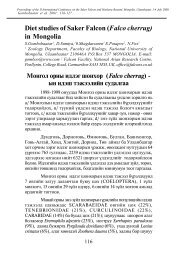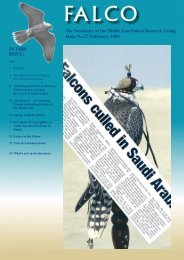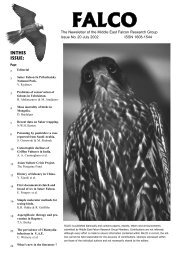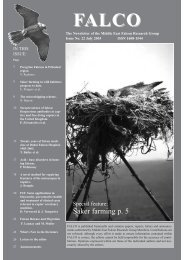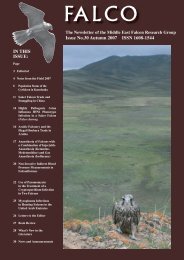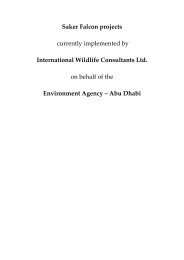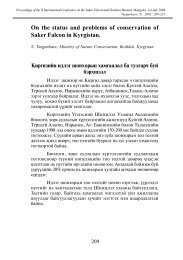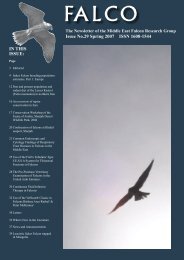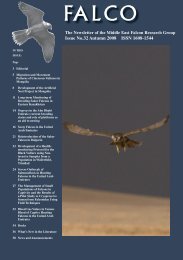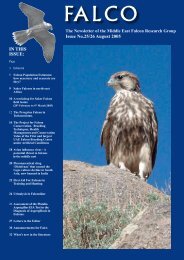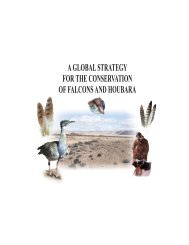Falco 28 - International Wildlife Consultants Ltd.
Falco 28 - International Wildlife Consultants Ltd.
Falco 28 - International Wildlife Consultants Ltd.
Create successful ePaper yourself
Turn your PDF publications into a flip-book with our unique Google optimized e-Paper software.
Letters:<br />
Avian Influenza Vaccination in <strong>Falco</strong>ns<br />
Dear Sir,<br />
We are writing to update you on some observations we<br />
have made regarding the use of avian influenza (AI)<br />
vaccines in falcons. <strong>Falco</strong>ns are susceptible to AI and<br />
highly pathogenic AI serotypes (H5 and H7) which have<br />
been isolated in the peregrine falcon (<strong>Falco</strong> peregrinus),<br />
saker falcon (F. cherrug), common buzzard (Buteo<br />
buteo) and crested hawk eagle (Spizaetus nipalensis)<br />
(Magnino et al., 2000; Manvell et al., 2000; Van Borm<br />
et al., 2005).<br />
In order to predict the efficacy of the vaccination in<br />
falcons, inactivated H5N2 vaccine (Nobilis Influenza<br />
H5, Intervet) was given subcutaneously to 30 healthy<br />
birds receiving routine examinations at Dubai <strong>Falco</strong>n<br />
Hospital (DFH) from November 2005 to January 2006.<br />
The birds included 12 gyr falcons (F. rusticolus), 2<br />
peregrine falcons, 1 saker falcon and 15 gyr-hybrids.<br />
<strong>Falco</strong>ns 1kg<br />
received 1ml. A second dose was given in all cases, but<br />
most of the falconers did not follow the recommended<br />
vaccination protocol and return for the booster after<br />
3-4 weeks. Pre- and post first vaccination titres were<br />
investigated in all falcons, but it was possible to check<br />
one bird after the booster vaccination. The serological<br />
technique used to detect antibody to H5N2 was<br />
haemagglutination inhibition (Obon et al., in press).<br />
On day zero, 27 birds were negative for AIV antibodies,<br />
while 3 falcons, one peregrine and two hybrids, tested<br />
positive. These three seropositive birds were excluded<br />
from the study (Table 1, P1, H6, H15). A second blood<br />
sample was taken the same day the second dose of<br />
vaccine was given. No adverse reactions were noted<br />
following the use of the vaccine in falcons.<br />
An irregular seroconversion rate was observed (Table<br />
1). Only 15 of 27 birds developed antibodies against<br />
avian influenza after the first vaccination. A clue for<br />
this lack of uniformity in the results could be that the<br />
falcons were vaccinated and sampled to check for<br />
humoral response at different time intervals. While<br />
some were sampled soon (1-3 weeks after primary<br />
vaccination), others were sampled late (up to 14 weeks<br />
after primary vaccination). Another explanation for<br />
the irregular seroconversion could be that the falcons<br />
received other vaccines (for paramyxovirus type 1 and<br />
poxvirus). It is possible that these vaccines interfered<br />
with the seroconversion to the AI vaccine. We did not<br />
have control animals in our field study, so we cannot<br />
rule out the possibility that seroconversion may have<br />
occurred because of exposure to field virus. Although<br />
no H5 cases were reported in the UAE during this time,<br />
many of these birds went on hunting trips to countries<br />
where H5 has been reported (Saudi Arabia and Pakistan)<br />
and the possibility of contact with infected animals<br />
cannot be ruled out.<br />
Although the titres recorded in the falcons were<br />
intermediate level, we have to consider that these<br />
animals had only received one dose of vaccine at that<br />
stage and a higher protection could be expected after the<br />
booster. In a parallel study on the efficacy of inactivated<br />
H5N2 vaccine on different exotic bird species, higher<br />
titres of AI antibodies were recorded one month after<br />
a booster dose of vaccine (Obon et al., in press). We<br />
do not know what titres are protective in falcons, but if<br />
we compare our results with poultry (Tian et al., 2005),<br />
it appears that there is a good immune response in the<br />
seropositive birds. It is known from experimental data<br />
in poultry that vaccination protects against clinical signs<br />
and mortality, reduces virus shedding and increases<br />
resistance to infection (Capua et al., 2004). However,<br />
the virus is still able to replicate and shed in clinically<br />
healthy vaccinated birds and careful use of vaccines<br />
in animals that could be exposed to infected animals<br />
is important. It would be interesting to vaccinate and<br />
test all birds on a similar schedule because these results<br />
show a clear lack of uniformity and it is difficult to draw<br />
many conclusions about the efficacy of the vaccine. A<br />
more detailed study is needed to understand the efficacy<br />
of inactivated AI vaccines in falcons.<br />
Acknowledgments<br />
We thank H.H Sheik Hamdan bin Rashid al Maktoum for<br />
his support of the DFH. We also thank Mr.Humaid Obaid<br />
al Muhari and the staff of the DFH and the CVRL for their<br />
technical support.<br />
References<br />
Capua I, Terregino C, Cattoli G, Toffan A. (2004). Increased<br />
resistance of vaccinated turkeys to experimental infection with an<br />
H7N3 low pathogenicity avian influenza virus. Avian Pathology<br />
33:158–63.<br />
Magnino, S., Fabbi, M., Moreno, A., Sala, G., Lavazza, A., Ghelfi,<br />
E., Gandolfi, L., Pirovano, G. and Gasperi, E.(2000). Avian<br />
influenza virus (H7 serotype) in a saker falcon in Italy. Veterinary<br />
Record 146 (25):740.<br />
Manvell, R.J., McKinney, P., Wernery, U. and Frost, K. (2000).<br />
Isolation of a highly pathogenic influenza A virus of subtype<br />
H7N3 from a peregrine falcon (<strong>Falco</strong> peregrinus). Avian<br />
Pathology 29, 635-637.<br />
Obon, E., Bailey, T., Kent, J., O’Donovan, D., Mc Keown, S.,<br />
Joseph, S. & Wernery, U. (in press) Humoral response to H5N2<br />
vaccination in exotic birds in the UAE. Veterinary Record.<br />
Tian, G., Zhang, S., Li, Y., Bu, Z., Liu, P., Zhou, J., Li, C., Shi, J.,<br />
Yu, K. & Chen, H. (2005). Protective efficacy in chickens, geese<br />
and ducks of an H5N1-inactivated vaccine developed by reverse<br />
genetics. Virology. 341(1), 153-162.<br />
Van Borm, S., Thomas, I., Hanquet, G., Lambrecht, B., Boschmans,<br />
M., Dupont, G., Decaestecker, M., Snacken, R., and Van den<br />
Berg, T. (2005). Highly pathogenic H5N1 influenza in smuggled<br />
Thai eagles, Belgium. Emerging Infectious Diseases. 11(5), 702-<br />
705.<br />
23



